Learning and Cognition Assignment
Added on 2022-08-18
24 Pages8241 Words14 Views
Running head: LEARNING AND COGNITION
Learning and Cognition
Name of the Student:
Name of the University:
Author note:
Learning and Cognition
Name of the Student:
Name of the University:
Author note:
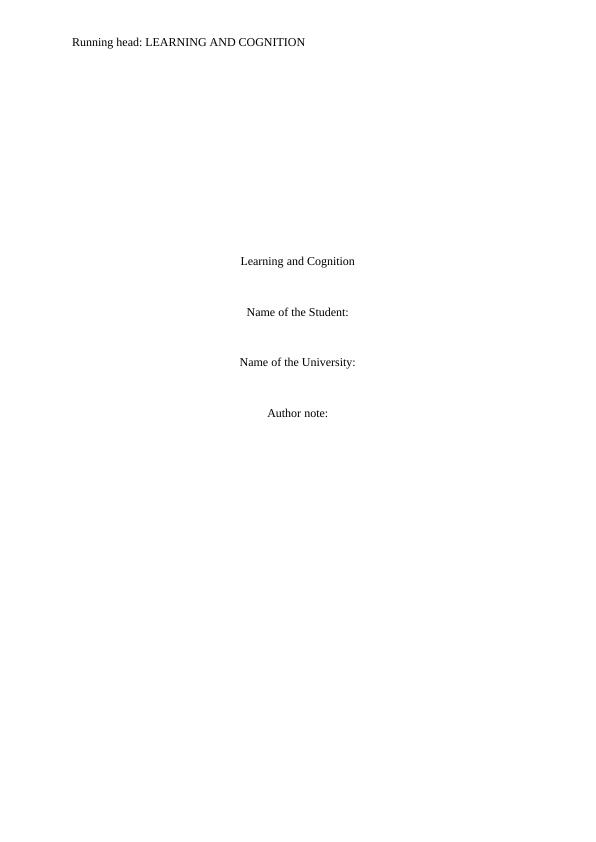
LEARNING AND COGNITION1
Sir Ken Robinson and Learning
Summary on the view of Sir Ken characteristics
Sir Ken Robinson is an international educator from Los Angeles, California. He is
widely known as a speaker on the subject of human resources, innovation and creativity in
education and business. “Do Schools Kill Creativity” is the most viewed TED talk of
Robinson in the event’s history. In this video, he has given a speech about the gaps in our
current education system along with the importance of creativity and the different types of
intelligence that need to be considered. Here he pleads for rethinking on the school system.
He has started his speech by raising awareness of the audience on the fact that the children
who start their schools now are likely to get retired by the year 2065. Therefore, it is the
function of a teacher to educate the children in terms of the unpredictability of the upcoming
and future events.
For him, education is a dynamic system that is constantly in flux and changing. He
opines that education prevails in the everyday activities and actions of the people. In the
video he claims that “schools kill creativity”, arguing that people do not grow into creativity,
but that they grow out of it. For him, creativity is as important as literacy. In this video, he
also cites an example of a young girl of 8 years old, named Gillian Lynne as an evidence of
how schools kill creativity. She was considered as a problem student by her school as she was
suffering from an inability of sitting still and concentrates. Today, Gillian Lynne, at the age
of 92, us a successful choreographer with a good number of achievements like Phantom of
the Opera, Andrew Lloyd-Webber’s Cats etc. But, her school written her off claiming that
she is suffering from cognitive impairment. In this way, her school tried to kill her
extraordinary talent.
Robinson has opined that every education system on this earth will have same
hierarchy of subjects- the Languages and Mathematics are always rated higher than the
Humanities. And again, Humanities is rated higher than the Arts. And this is not the end.
Within Arts, there will be a future gradation- Music and Arts are rated higher than Dance and
Drama. As per him, the net outcome of an education is focused on the heads of children,
Sir Ken Robinson and Learning
Summary on the view of Sir Ken characteristics
Sir Ken Robinson is an international educator from Los Angeles, California. He is
widely known as a speaker on the subject of human resources, innovation and creativity in
education and business. “Do Schools Kill Creativity” is the most viewed TED talk of
Robinson in the event’s history. In this video, he has given a speech about the gaps in our
current education system along with the importance of creativity and the different types of
intelligence that need to be considered. Here he pleads for rethinking on the school system.
He has started his speech by raising awareness of the audience on the fact that the children
who start their schools now are likely to get retired by the year 2065. Therefore, it is the
function of a teacher to educate the children in terms of the unpredictability of the upcoming
and future events.
For him, education is a dynamic system that is constantly in flux and changing. He
opines that education prevails in the everyday activities and actions of the people. In the
video he claims that “schools kill creativity”, arguing that people do not grow into creativity,
but that they grow out of it. For him, creativity is as important as literacy. In this video, he
also cites an example of a young girl of 8 years old, named Gillian Lynne as an evidence of
how schools kill creativity. She was considered as a problem student by her school as she was
suffering from an inability of sitting still and concentrates. Today, Gillian Lynne, at the age
of 92, us a successful choreographer with a good number of achievements like Phantom of
the Opera, Andrew Lloyd-Webber’s Cats etc. But, her school written her off claiming that
she is suffering from cognitive impairment. In this way, her school tried to kill her
extraordinary talent.
Robinson has opined that every education system on this earth will have same
hierarchy of subjects- the Languages and Mathematics are always rated higher than the
Humanities. And again, Humanities is rated higher than the Arts. And this is not the end.
Within Arts, there will be a future gradation- Music and Arts are rated higher than Dance and
Drama. As per him, the net outcome of an education is focused on the heads of children,

LEARNING AND COGNITION2
instead of their bodies and these further results into a system that is aimed at forming
university professors.
One of the key features of the argument presented by Ken Robinson is the
industrialisation and standardisation of the British schools system kill the creativity by
stifling the individual creativity like the artistic one or any other forms of creative expression
or thinking. According to Robinson, the school system was built for meeting the needs of the
industrialism and is therefore dependent on two key ideas- the value of an individual for the
school system, and they are- a) the most useful subjects for work are at the top and b) an
individual’s “academic ability. He has also summed up some serious issues that we are likely
to face in the coming future. He states that the data of UNESCO suggests that in the coming
30 years more number of people would be graduating through education than there have been
ever before. With the same, the progress in technology might lead to the substitution of work
that are so far performed by the human beings. The next issue would be the explosion in the
human population. It will result in the “process of academic inflation”. According to
Robinson, we must rethink about the way in which we presently see intelligence. We see it
visually and kinaesthetically. But, we must see it as diverse, distinct and dynamic.
Again, in the video titled “Bring on the Learning Revolution”, Robinson makes a
radical shift from the case of standardised schools to personalised learning where one would
create the conditions where the natural talents could flourish. In this video he argues that we
often do not get the best out of people because we all have been educated for becoming good
workers instead of being creative thinkers. He claims that schools educate children out of
their creativity and we need to change the current educational system from a linear and
industrial model of education to a model based on organic and agriculture. People need to be
able of customising the education as per the needs of the individuals in order to ensure that
people can create their own solutions on the basis of personalised curriculum.
In the video titles “How to Escape Education's Death Valley”, Robinson challenges
the way in which the modern parents are educating their children. He advocates on a radical
rethink about the current school systems for cultivating creativity among students and
acknowledging many types of intelligence. He emphasises on the notion that the current
instead of their bodies and these further results into a system that is aimed at forming
university professors.
One of the key features of the argument presented by Ken Robinson is the
industrialisation and standardisation of the British schools system kill the creativity by
stifling the individual creativity like the artistic one or any other forms of creative expression
or thinking. According to Robinson, the school system was built for meeting the needs of the
industrialism and is therefore dependent on two key ideas- the value of an individual for the
school system, and they are- a) the most useful subjects for work are at the top and b) an
individual’s “academic ability. He has also summed up some serious issues that we are likely
to face in the coming future. He states that the data of UNESCO suggests that in the coming
30 years more number of people would be graduating through education than there have been
ever before. With the same, the progress in technology might lead to the substitution of work
that are so far performed by the human beings. The next issue would be the explosion in the
human population. It will result in the “process of academic inflation”. According to
Robinson, we must rethink about the way in which we presently see intelligence. We see it
visually and kinaesthetically. But, we must see it as diverse, distinct and dynamic.
Again, in the video titled “Bring on the Learning Revolution”, Robinson makes a
radical shift from the case of standardised schools to personalised learning where one would
create the conditions where the natural talents could flourish. In this video he argues that we
often do not get the best out of people because we all have been educated for becoming good
workers instead of being creative thinkers. He claims that schools educate children out of
their creativity and we need to change the current educational system from a linear and
industrial model of education to a model based on organic and agriculture. People need to be
able of customising the education as per the needs of the individuals in order to ensure that
people can create their own solutions on the basis of personalised curriculum.
In the video titles “How to Escape Education's Death Valley”, Robinson challenges
the way in which the modern parents are educating their children. He advocates on a radical
rethink about the current school systems for cultivating creativity among students and
acknowledging many types of intelligence. He emphasises on the notion that the current
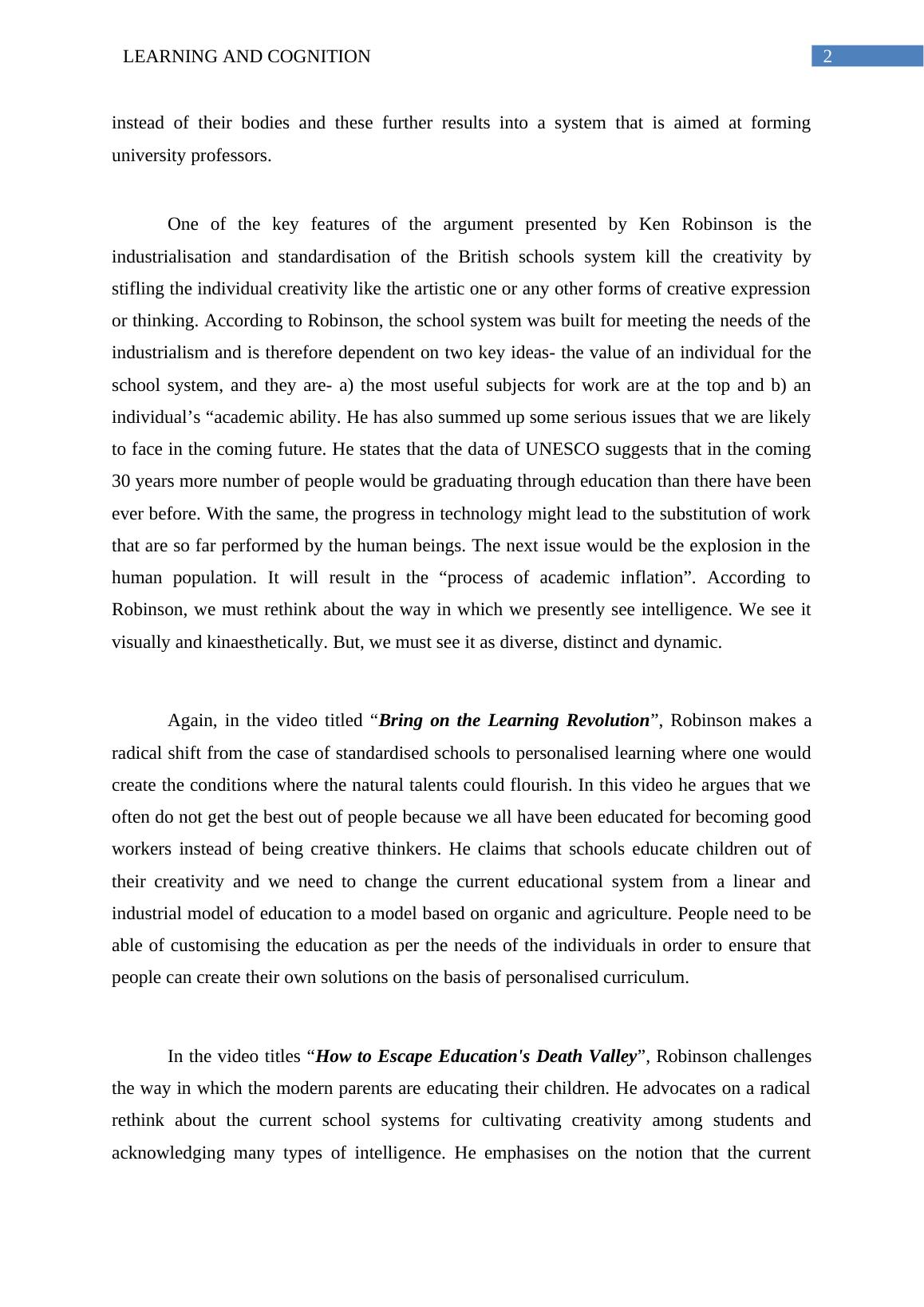
LEARNING AND COGNITION3
culture of education needs a revolution and for getting the best out of the schools, we need to
acknowledge the fact that human beings are naturally diverse and different, that children are
naturally curious and that the life of human beings is inherently creative. This is why,
children are required to be given with a broad curriculum so that they can celebrate and
develop their various talents.
Teachers have a great role to play in this regard as they must facilitate children’s
learning through engaging, provoking, stimulating, mentoring and delivering. According to
Robinson, children have the seeds of an immense range of possibilities waiting and these
seeds, with right conditions, are likely to flourish. He opined that there are three key
principles that are important for the human mind to develop and they are- a) curiosity, b)
diversity and c) creativity. The current culture of education works against these three
principles. He in this video also concludes with his opinion that the actual role of leadership
in education is climate control and creating a climate of immense possibilities and that we
need a revolution now.
The fact that Sir Ken Robinson perceives school systems to constrict the creativity of
students by means of standardising the education is again proven through his video titled
“Expanding Our Definition of Smart”. One of the main features of the argument by Ken
Robinson is the industrialisation and standardisation of the British schools system kill the
creativity by stifling the individual creativity like the artistic one or any other forms of
creative expression or thinking. He claims that the schools are stifling the creativity of the
students. Changing the education system is what Robinson has been all about for these years.
He emphasises on making a more personalised education for the students that are customised
enough as per the communities in which they are part of. He claims that education over the
last twenty years is increasingly seen as a type of strategic issue for the governments
worldwide.
In this video again, Robinson states that the school system was built for meeting the
needs of the industrialism. He in this video does an excellent work of highlighting what is
going in the current education system while asking the questions regarding how we can do
better. He also applies the concept of organic farming in the schools. There are a total of four
culture of education needs a revolution and for getting the best out of the schools, we need to
acknowledge the fact that human beings are naturally diverse and different, that children are
naturally curious and that the life of human beings is inherently creative. This is why,
children are required to be given with a broad curriculum so that they can celebrate and
develop their various talents.
Teachers have a great role to play in this regard as they must facilitate children’s
learning through engaging, provoking, stimulating, mentoring and delivering. According to
Robinson, children have the seeds of an immense range of possibilities waiting and these
seeds, with right conditions, are likely to flourish. He opined that there are three key
principles that are important for the human mind to develop and they are- a) curiosity, b)
diversity and c) creativity. The current culture of education works against these three
principles. He in this video also concludes with his opinion that the actual role of leadership
in education is climate control and creating a climate of immense possibilities and that we
need a revolution now.
The fact that Sir Ken Robinson perceives school systems to constrict the creativity of
students by means of standardising the education is again proven through his video titled
“Expanding Our Definition of Smart”. One of the main features of the argument by Ken
Robinson is the industrialisation and standardisation of the British schools system kill the
creativity by stifling the individual creativity like the artistic one or any other forms of
creative expression or thinking. He claims that the schools are stifling the creativity of the
students. Changing the education system is what Robinson has been all about for these years.
He emphasises on making a more personalised education for the students that are customised
enough as per the communities in which they are part of. He claims that education over the
last twenty years is increasingly seen as a type of strategic issue for the governments
worldwide.
In this video again, Robinson states that the school system was built for meeting the
needs of the industrialism. He in this video does an excellent work of highlighting what is
going in the current education system while asking the questions regarding how we can do
better. He also applies the concept of organic farming in the schools. There are a total of four
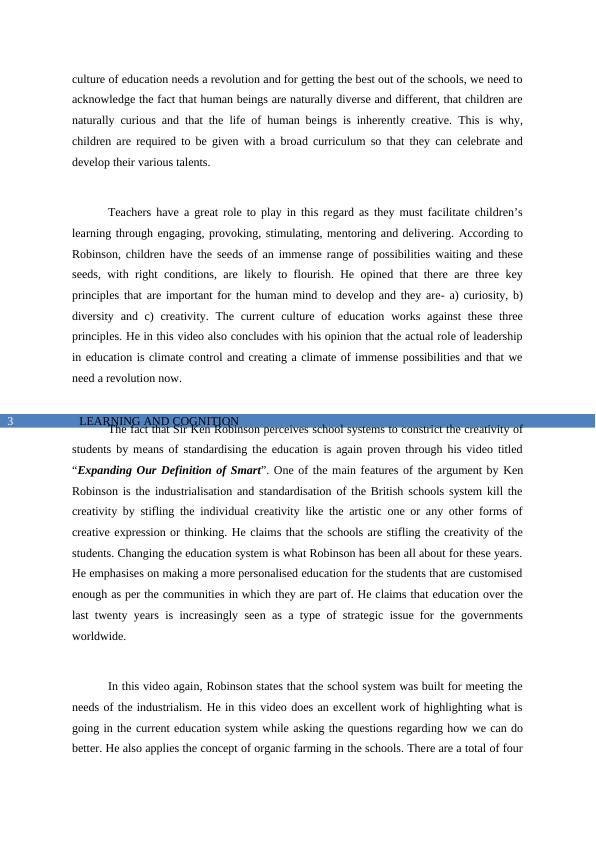
LEARNING AND COGNITION4
principles of organic farming that Robinson applies to the schools and they are health, care,
ecology and fairness. If the schools implement these four principles, all the students would be
benefitted automatically.
Every learner has different constructions and interpretation of knowledge process that
is completely based on the mental representations. Traditional teaching approach does not
involve the students in creative thinking and collaborative participation in creative activities.
It is also to mention that Robinson spends a lot of time on the notion that children are natural
learners. A child always wants to learn but often the schools in which he or she is admitted in
is not designed for his or her optimal learning. Outside the school, people are able of devoting
huge chunks of time on the projects and not much at the schools. We move the learners every
45 to 60 minutes and then complain that the students cannot pay attention. To this problem,
Robinson believes that personalisation is the answer.
principles of organic farming that Robinson applies to the schools and they are health, care,
ecology and fairness. If the schools implement these four principles, all the students would be
benefitted automatically.
Every learner has different constructions and interpretation of knowledge process that
is completely based on the mental representations. Traditional teaching approach does not
involve the students in creative thinking and collaborative participation in creative activities.
It is also to mention that Robinson spends a lot of time on the notion that children are natural
learners. A child always wants to learn but often the schools in which he or she is admitted in
is not designed for his or her optimal learning. Outside the school, people are able of devoting
huge chunks of time on the projects and not much at the schools. We move the learners every
45 to 60 minutes and then complain that the students cannot pay attention. To this problem,
Robinson believes that personalisation is the answer.
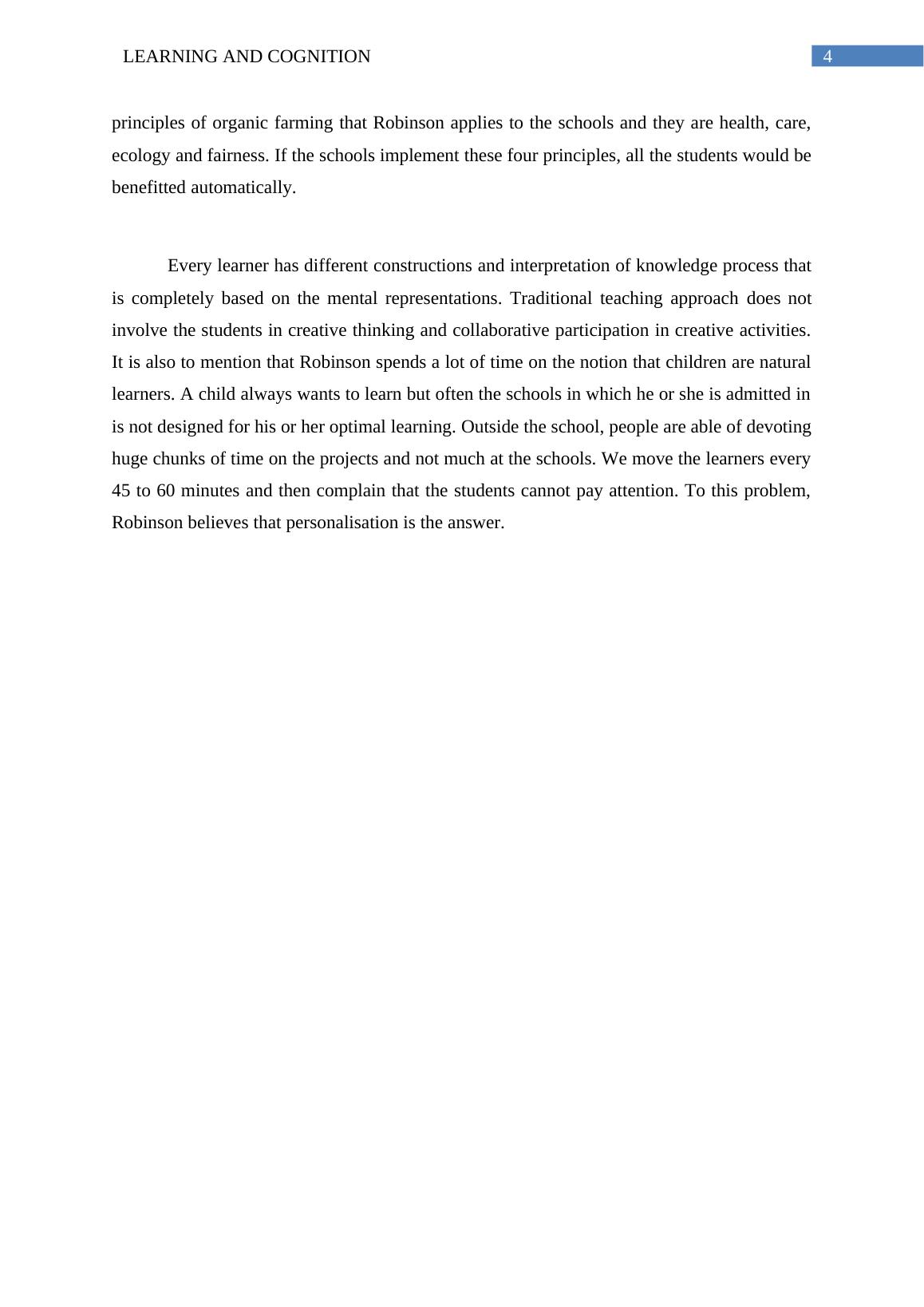
LEARNING AND COGNITION5
Reflection (2 pages)
a. Do you agree with the views expressed? Explain.
Yes I agree. Robinson’s speech is really interesting for me as I am greatly interested in
education and I hope to be working in the educational sector. I believe that every individual
in this earth should have the right access to a supporting and good education. And as a
student, I am very thankful that there are people like Sir Ken Robinson who legitimately care
about our education. He is brilliant guy with a great sense of humour. After listening his
speech in these four videos, I have realised that global warming is not the only crisis that the
world is facing today. Along with the natural resources, the human resources too are in deep
peril. The present educational model actually distances the people from their true talents and
this is why I can see many people I know to feel passionate about their work and many who
believe that they have absolutely no talents at all. I totally agree with whatever Robinson
claims and argued.
b. What lessons can be learned for schools?
According to Robinson, “personalisation” is the answer to all the problems related to
education system and school system. In most of the schools, the traditional method that is
used ignores the students, particularly their mental level of interest. They involve the
coverage of the context and rote memorization on the students’ part. What is more daunting
is that the rote learning and memorization seems to be the dominant model at all the levels.
The teaching in schools does not involve the students in creative thinking and collaborative
participation in creative activities. Many of the times it can be seen that during the teaching
and learning process, instruction are remained unilateral and this can be considered as an
orthodox activity.
Every individual has different constructions and interpretation of knowledge process that
is completely based on the mental representations. Traditional teaching approach does not
involve the students in creative thinking and collaborative participation in creative activities.
Reflection (2 pages)
a. Do you agree with the views expressed? Explain.
Yes I agree. Robinson’s speech is really interesting for me as I am greatly interested in
education and I hope to be working in the educational sector. I believe that every individual
in this earth should have the right access to a supporting and good education. And as a
student, I am very thankful that there are people like Sir Ken Robinson who legitimately care
about our education. He is brilliant guy with a great sense of humour. After listening his
speech in these four videos, I have realised that global warming is not the only crisis that the
world is facing today. Along with the natural resources, the human resources too are in deep
peril. The present educational model actually distances the people from their true talents and
this is why I can see many people I know to feel passionate about their work and many who
believe that they have absolutely no talents at all. I totally agree with whatever Robinson
claims and argued.
b. What lessons can be learned for schools?
According to Robinson, “personalisation” is the answer to all the problems related to
education system and school system. In most of the schools, the traditional method that is
used ignores the students, particularly their mental level of interest. They involve the
coverage of the context and rote memorization on the students’ part. What is more daunting
is that the rote learning and memorization seems to be the dominant model at all the levels.
The teaching in schools does not involve the students in creative thinking and collaborative
participation in creative activities. Many of the times it can be seen that during the teaching
and learning process, instruction are remained unilateral and this can be considered as an
orthodox activity.
Every individual has different constructions and interpretation of knowledge process that
is completely based on the mental representations. Traditional teaching approach does not
involve the students in creative thinking and collaborative participation in creative activities.
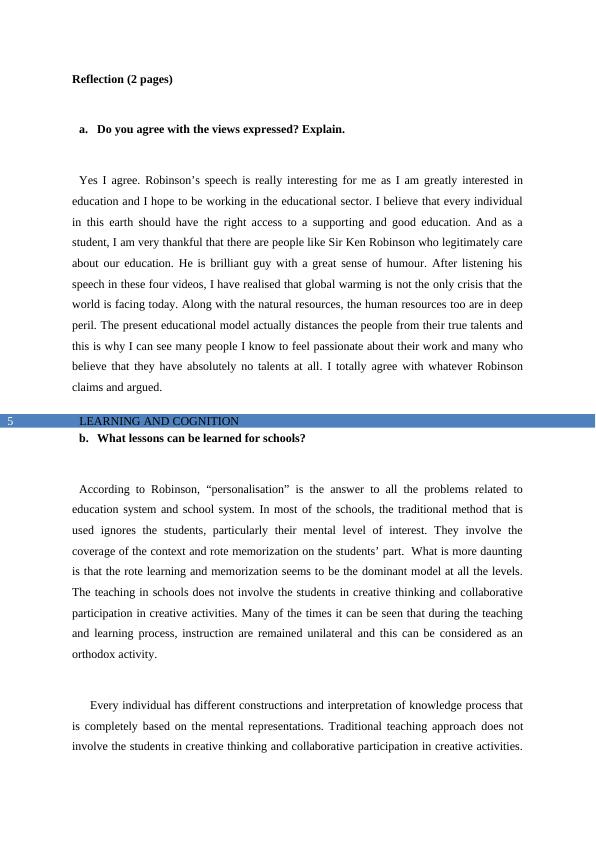
End of preview
Want to access all the pages? Upload your documents or become a member.
Related Documents
The Implementation of Ken Robinson’s Ideas on Education, Creativity, and Personal Growthlg...
|4
|562
|223
Education Kills Creativity: True or False?lg...
|11
|698
|402
